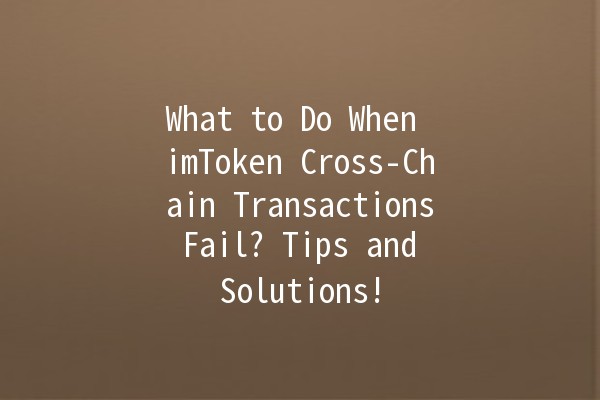Crosschain transactions are essential in a decentralized finance (DeFi) ecosystem, as they enable users to transfer assets between different blockchain networks. imToken, a widely used digital asset wallet, supports crosschain functionalities, allowing users to seamlessly manage their assets across various blockchains. However, like any technological process, failures can occur during these transactions. Knowing how to react in such situations can save users a lot of time and resources.
In this article, we will explore some practical tips and methods for dealing with imToken crosschain transaction failures. We will highlight actionable steps including error identification, using transaction IDs, checking network conditions, and enhancing communication with support channels. Each tip aims to provide users with clarity on how to move forward when they encounter issues with their transactions.
Before diving into solutions, it's important to understand why crosschain transactions might fail. Here are some common reasons:

Understanding these reasons can help users better diagnose problems and find effective solutions.
The first step in resolving a failed transaction is understanding the error message. When a transaction fails, imToken typically provides a notification or error message explaining the issue.
Carefully read the error message provided by imToken.
If the message mentions “insufficient funds,” ensure there are enough funds available in the selected wallet.
This simple identification process can save time by directing users to the core issue rather than exploring unnecessary steps.
Every transaction on a blockchain is associated with a unique transaction ID (TXID). Users can use this ID to track their transaction through blockchain explorers to see its status.
Go to a relevant blockchain explorer (for instance, Etherscan for Ethereum).
Enter the TXID into the search bar to view the transaction’s status. If the transaction is pending or has failed, this information can guide your next steps.
By tracking the transaction, users gain insight into whether the failure was due to network conditions or other issues.
Occasionally, failures may arise due to broader network issues. Before proceeding with another transaction, checking the status of both the source and target networks can be helpful.
Visit the official status pages for the respective blockchain networks (e.g., Ethereum or Binance Smart Chain).
Confirm if there are any ongoing issues or maintenance activities. If there are known problems, users may need to wait until the situation is resolved before attempting a new transaction.
Accessing this information can prevent unnecessary retries when the network is already overloaded or experiencing outages.
One common reason for transaction failures is setting too low of a gas fee. To encourage miners to process the transaction promptly, it’s essential to include an appropriate gas fee.
Use gas fee estimation tools (like Gas Station for Ethereum) to determine a suitable amount.
In imToken, when submitting a transaction, select a gas price that reflects current network conditions (e.g., average or high fee recommendations).
By optimizing gas fees, users can significantly reduce the chance of transaction failures due to low fee settings.
If users have tried the above steps without success, contacting imToken’s support team can provide valuable assistance. The support team can investigate further or offer additional solutions.
Prepare relevant details such as the transaction ID, error message, and steps already taken to resolve the issue.
Seek help via official support channels like email or other communication platforms listed in imToken.
By providing detailed information to the support team, users can expedite the resolution process.
To minimize the occurrences of transaction failures in the future, users can implement certain best practices.
Always doublecheck the selected network: Make sure you are using the correct network for your transactions.
Stay updated on blockchain status and updates: Subscribing to news feeds or community updates can help keep users informed about network conditions.
Maintain sufficient funds for gas fees: Always ensure a small balance is available in the wallet for transaction fees to prevent halted transactions.
By adopting these preventive measures, users can streamline their future transaction experiences.
When you experience a failed transaction, first check the error message and transaction ID (TXID). This will provide clarity on the issue and allow you to track the transaction status using a blockchain explorer.
You can track your failed transaction by using the TXID on a relevant blockchain explorer. Simply enter the TXID in the search bar to view details regarding its status, helping determine if it is pending or has failed.
Yes, there are gas fees associated with each transaction on the blockchain. If you decide to resubmit a transaction, ensure you allocate enough gas fees to avoid further failures.
If your transaction is stuck in a pending state, check the current gas prices and consider increasing the gas fee. You may also wait for network congestion to decrease before retrying.
Keeping track of network statuses is crucial as it helps you avoid submitting transactions during times of high congestion or outages. This practice can minimize the likelihood of failed transactions.
ImToken provides support through its help center, where users can find articles related to common issues. Users are encouraged to reach out to the support team with specific details related to their issues to receive personalized help.
With these practical tips and insights, users can proficiently navigate through challenges encountered during imToken crosschain transactions. Implementing these strategies effectively can lead to smoother user experiences and better management of digital assets.